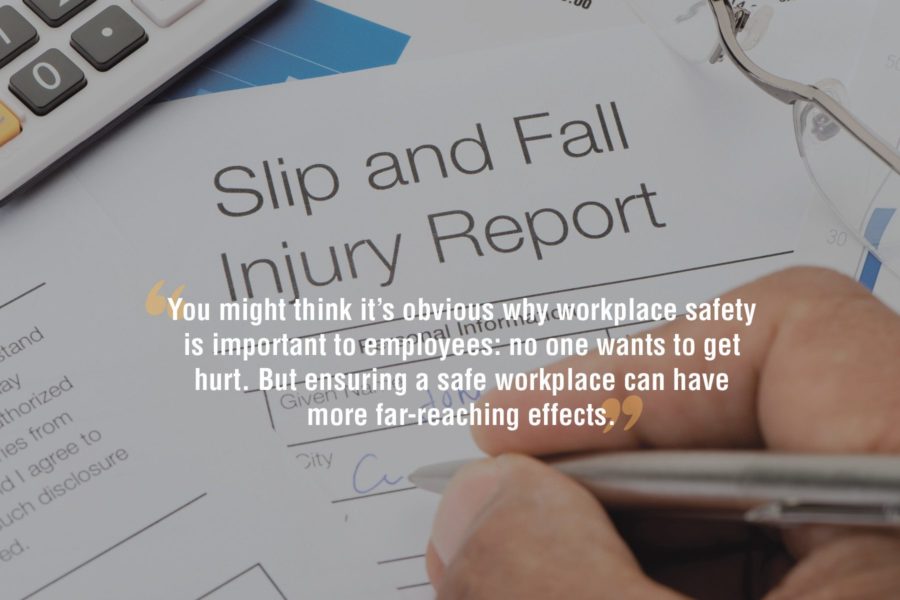Workplace safety is important to the health and welfare of employees and the overall health and productivity of a company. According to the Bureau of Labor Statistics (BLS), private industry employers reported 2.8 million nonfatal workplace injuries and illnesses in 2019. Of those, 882,200 caused a private industry worker to miss at least one day of work.
Most Common Causes of Workplace Injuries
The most common causes of workplace injuries include:
- Overexertion and bodily reactions
- Falls, slips and trips
- Contact with objects or equipment
- Violence and other injuries caused by persons or animals
- Transportation accidents
Most Common Workplace Safety Hazards
The most common workplace safety hazards include:
- Slips, trips and falls
- Being caught in or struck by moving machinery or other objects
- Fire and explosions
- Transportation and vehicle‐related accidents
- Confined spaces
- Violence
Workplace Safety and COVID-19
In the past year, nearly every organization has been faced with an unprecedented issue: protecting employees when it comes to COVID-19 transmission. Workplace exposure to COVID-19 is a real risk, especially in jobs that require employees to work in close quarters or with the public. While many companies have pivoted to a largely remote workforce, telework is not an option for some industries.
Just recently, the Occupational Safety and Health Administration (OSHA) issued updated guidance and recommendations outlining existing safety and health standards. Elements of the guidelines include:
- A stronger stance on face coverings for employees, including recommending a face covering requirement for non-employees and visitors while on the premises. Reasonable accommodations should be discussed for any employee unable to wear a face covering due to a disability.
- Adherence to key measures for limiting the spread of COVID-19, including social distancing, installing barriers where physical distancing cannot be maintained, using personal protective equipment (PPE) when necessary, improving ventilation, providing supplies for good hygiene and enhancing sanitation of the workplace.
- The implementation of COVID-19 prevention programs that include conducting a hazard assessment, identifying ways to limit the spread of COVID-19 in the workplace, adopting measures to ensure that workers who are infected with or exposed to COVID-19 are not present in the workplace and protecting workers who raise COVID-19 related concerns from retaliation.
OSHA has also clarified its reporting policies regarding COVID-19. Unlike most work-related incidents that must be reported within 24 hours, a hospitalization due to COVID-19 must happen within 24 hours of an exposure to the virus at work before qualifying as reportable. In addition, the employer must report the hospitalization within 24 hours of knowing that the employee has been hospitalized and that the reason for hospitalization was a work-related case of COVID-19.
Regarding an employee death from COVID-19, employers have eight hours from the time they learn of the death as a work-related case of COVID-19 to report it to OSHA.
Employers must still record work-related cases of COVID-19 as well as deaths. Recording involves contacting OSHA and giving them pertinent information that could launch an OSHA inspection. Recording is simply noting a work-related incident internally, which is not necessarily reported to OSHA.
Finally, a point of contact for questions or concerns about workplace safety should be communicated to all employees, and they should be made aware that any retaliation against raising workplace health and safety concerns is prohibited. OSHA recommends implementing a hotline or other anonymous method to help assuage any fears employees may have about employer retaliation.
Reasons Why Workplace Safety is Important to Employees
You might think it’s obvious why workplace safety is important to employees: no one wants to get hurt. But ensuring a safe workplace can have more far-reaching effects.
Increases Productivity
A safe work environment results in fewer injuries, and fewer injuries means fewer employees off work. Do the math and that means you don’t lose productivity because of employee absenteeism due to injury.
Promotes Wellness
If you are a company that has a stringent safety program, you’re also promoting employee wellness. Good safety programs don’t just mean protecting your employees from injury; they also encourage employees to take a proactive approach to not only keep safe on the job, but keep themselves healthy so they are less likely to become injured.
Increases Employee Satisfaction
If employees feel like their employer is truly concerned about their safety, they will feel safer in their jobs and more confident in performing their job duties. Employees who feel their safety is an employer’s priority will also experience less workplace stress.
Reasons Workplace Safety is Important to Employers
Increases Employee Retention
Employees who feel safe in their jobs are more likely to feel as if their employer cares about their well-being and enjoy a safer working environment. Given that, they are more likely to stay with your company versus looking for work elsewhere. Harvard Business Review points out companies that protect workers against negative events frequently can reduce employee stress and create positive working conditions.
Reduces Worker’s Compensation Claims
Obviously, the fewer injuries you have on the job, the fewer worker’s compensation claims you’ll have. Comparatively, a company-wide commitment to safety in the workplace limits the risk of on-the-job accidents and injuries, along with employee insurance claims related to these incidents.
Lowers Employee Absenteeism
The BLS estimates that companies suffer more than $40 billion in annual financial losses due to employee absenteeism. Conversely, the National Safety Council found that each prevented lost-time injury or illness saves an employer an average of $37,000.
Improves Reputation
If your company has a reputation for employee accidents or injuries, you’re not going to attract the best talent. Employers with a reputation of having effective safety procedures and safe environments not only make employees feel more secure in their jobs, they have a more positive reputation in the industry as being a safe place to work.
Reduces Other Costs
Costs involved in workplace injuries not only come from worker’s compensation claims, but from medical expenses incurred, noncompliance fines, litigation expenses, property loss and other indirect costs. Lawsuits not only cost your company money; they damage your reputation as well.
Increases Efficiencies
Operations that are not well managed tend to be more unsafe than those that are. When businesses are safe, employees spend more time focusing on the work than worrying about their safety on the job. Unsafe work environments can be due to, in part, lax safety standards and careless safety practices, which means a decrease in quality. Safety increases focus, which increases quality, which in turn increases productivity and efficiencies.
Improves Employee Satisfaction
Companies that don’t invest in employee safety or don’t take employee safety seriously soon develop a reputation as an unsafe employer, which can have a negative effect on attracting and retaining good workers. Consequently, companies that implement rigorous employee safety practices and education are more likely to experience employee loyalty and longevity.
What Employers Can Do
Employers have a responsibility to provide a safe workplace. Some safety standards are required by law; others are steps employers can take to educate their employees and encourage good safety practices.
Adhere to Occupational Safety and Health Association (OSHA) Standards
Under OSHA law, employers have a responsibility to:
- Provide a workplace free from serious recognized hazards and comply with standards, rules and regulations issued under the OSH Act.
- Examine workplace conditions to make sure they conform to applicable OSHA standards.
- Make sure employees have and use safe tools and equipment and properly maintain this equipment.
- Use color codes, posters, labels or signs to warn employees of potential hazards.
- Establish or update operating procedures and communicate them so that employees follow safety and health requirements.
- Provide safety training in a language and vocabulary workers can understand.
- Post, at a prominent location within the workplace, the OSHA poster (or the state-plan equivalent) informing employees of their rights and responsibilities.
- Keep records of work-related injuries and illnesses.
Encourage a Culture of Workplace Safety
Safety in the workplace is more than just rules and regulations; it’s also inviting employees to help establish, evaluate and suggest improvements to safety best practices.
According to the U.S. Department of Labor, an effective safety and health culture consists of employees who:
- Are encouraged to participate in the program and feel comfortable providing input and reporting safety or health concerns.
- Have access to information they need to participate effectively in the program to improve their working environments.
- Have opportunities to participate in all phases of program design and implementation.
- Do not experience retaliation when they raise safety and health concerns; report injuries, illnesses and hazards; participate in the program; or exercise safety and health rights.
What does a good workplace safety culture look like?
According to OSHA, a good workplace safety culture consists of shared beliefs, practices and attitudes that exist at an establishment. Culture is the atmosphere created by those beliefs and attitudes that shape our behavior. But what does that look like?
You Have Leadership Buy-In
Workplace safety is nothing without support from the top. Leadership needs to show their commitment to safety practices and lead by example.
You Have Employee Input
Your employees are the heart of your workplace safety culture. Make sure you are actively engaging them via surveys, one-on-ones, open forums, etc. In addition, ensure your employees feel comfortable reporting issues and offering suggestions for change. If they feel as if they will be penalized – or worse yet – ignored, you’ll be hard-pressed to have a sense of the issues going on among your workforce.
You Identify Risk Factors
If you find that there are similar or recurring safety issues, don’t put a band-aid on it and move along. Make sure you identify the risk factors in any areas of your workplace and put in place safety protocols before an injury even has a chance to occur.
You Back Up Policies With Action
It’s easy to post policies, but if noticeable improvements aren’t being made and safety issues aren’t being solved, your culture of safety will suffer. Ensure that you are making a sound financial investment in safety within your workplace and that employees are aware of these improvements.
You Communicate Everything
Ensure you are communicating all policies, policy changes/enhancements and explanations to employees on a regular basis. Ideally, these communications are housed somewhere for easy employee access, such as a company intranet.
You Consider Safety a Priority
A company can have safety issues when safety isn’t considered a priority. Conversely, a company that views safety as an investment, its employees tend to not only perform better, but also have more satisfied employees.
Bottom line, a safe and healthy work environment is paramount to your company’s productivity, your business reputation and the health and well-being of your employees. Involving your employees in your health and safety program helps create a more collaborative work environment and improve overall employee morale. If you need help navigating workplace safety issues, contact our safety and loss control managers for help.





